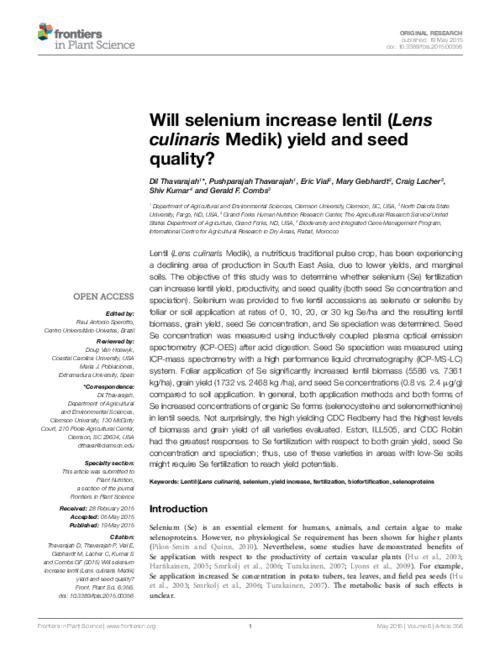Will selenium increase lentil (Lens culinaris Medik) yield and seed quality?
Abstract
Lentil (Lens culinaris Medik), a nutritious traditional pulse crop, has been experiencing a declining area of production in South East Asia, due to lower yields, and marginal soils. The objective of this study was to determine whether selenium (Se) fertilization can increase lentil yield, productivity, and seed quality (both seed Se concentration and speciation). Selenium was provided to five lentil accessions as selenate or selenite by foliar or soil application at rates of 0, 10, 20, or 30 kg Se/ha and the resulting lentil biomass, grain yield, seed Se concentration, and Se speciation was determined. Seed Se concentration was measured using inductively coupled plasma optical emission spectrometry (ICP-OES) after acid digestion. Seed Se speciation was measured using ICP-mass spectrometry with a high performance liquid chromatography (ICP-MS-LC) system. Foliar application of Se significantly increased lentil biomass (5586 vs. 7361 kg/ha), grain yield (1732 vs. 2468 kg /ha), and seed Se concentrations (0.8 vs. 2.4 μg/g) compared to soil application. In general, both application methods and both forms of Se increased concentrations of organic Se forms (selenocysteine and selenomethionine) in lentil seeds. Not surprisingly, the high yielding CDC Redberry had the highest levels of biomass and grain yield of all varieties evaluated. Eston, ILL505, and CDC Robin had the greatest responses to Se fertilization with respect to both grain yield, seed Se concentration and speciation; thus, use of these varieties in areas with low-Se soils might require Se fertilization to reach yield potentials

